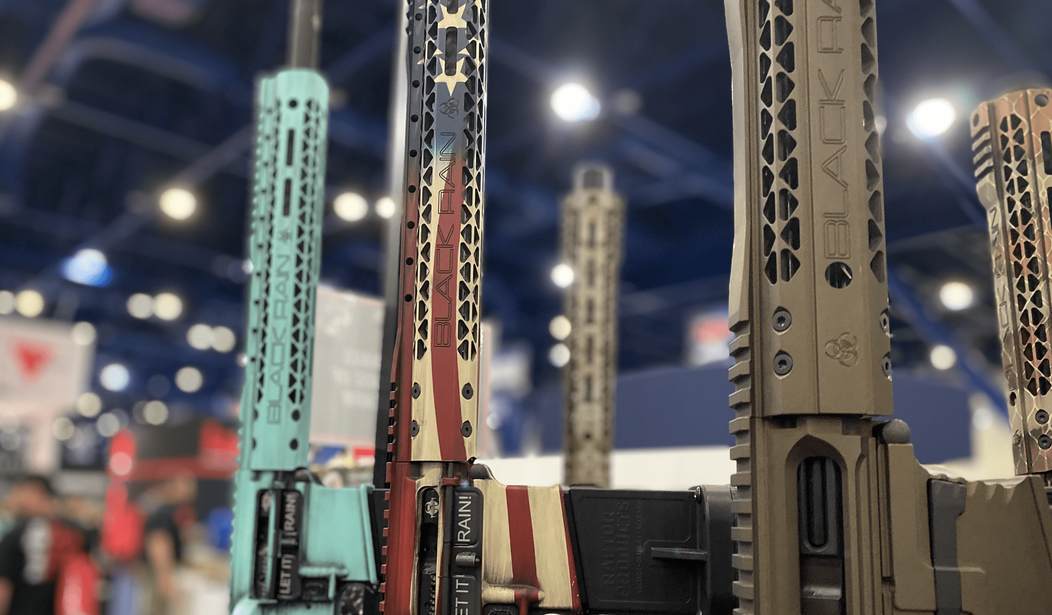The matter of those dirty nasty black rifles is being challenged the second time in one week in the Garden State. Cam reported about a Firearms Policy Coalition backed case, Cheeseman v. Platkin the other day, and on July 1st, the Association of New Jersey Rifle and Pistol Clubs (ANJRPC) also filed a suit challenging the unconstitutional provisions in New Jersey’s law, Ellman et.al. v. Platkin et.al.
The grant, vacate, and remand (GVR) in the Maryland case, Bianchi, Dominic, et.al. v. Frosh, a similar challenge to such a ban, shows promise. The prohibiting of a class of firearms that’s in common use, does not fit the bill of being both dangerous and unusual, and would not be banned at the time of our founding, would be considered unconstitutional.
July 1, 2022. This afternoon, ANJRPC filed a new federal lawsuit to overturn New Jersey’s infamous ban on cosmetically incorrect semi-automatic firearms, sometimes inaccurately referred to as “assault firearms.”
The move comes in the wake of yesterday’s action by the U.S. Supreme Court returning a Maryland assault weapons case to the lower federal courts there with a mandate to decide it once again, but this time under the new rules announced in Bruen. That strongly suggests that hardware bans like NJ’s “assault” firearms law may not survive scrutiny under Bruen.
This new lawsuit aims to put an end to New Jersey’s semi-auto ban, which is ignored by criminals and only restricts the rights of the honest citizens who follow it. Click here to see the Complaint in the new case.
Regardless that in a post Heller and McDonald world the prohibition of such arms does not fit constitutional muster, such a ban persisted. However, in a post NYSRPA v. Buren world, it’s crystal clear that the courts and lawmakers can no longer hide behind their “feelings”. A generalized statement that they’re looking after the welfare of the people/public safety no longer applies. Interesting that the burden of meeting “need” in many jurisdictions that were not issuing carry permits was not fulfilled by generalized fear for personal safety and relied upon specific needs or threats. Now, our lawmakers and public masters have to deal with that shoe on the other foot.
I took a chance to read the 16 page brief and it’s at moments down right poetic. Attorney Daniel L. Schmutter from Harman & Winnicki, representing plaintiffs Ellman, Rogers, and ANJRPC, lays out in the introduction exactly what the issue at hand is. In black and white the complaint states:
1. The State of New Jersey has criminalized one of the most common and important means by which its citizens exercise their fundamental right of self-defense. By banning common semi-automatic firearms, the State has reached into the homes—the most intimate of private spaces—of its law-abiding citizens, and invaded their constitutional right to keep and bear arms for the defense of themselves and their families.
2. Without relief from this Court, Defendants will continue to violate the constitutional rights of New Jersey’s law-abiding citizens and reinforce the erroneous notion that the right to keep and bear arms is nothing more than “a second-class right, subject to an entirely different body of rules than the other Bill of Rights guarantees.” McDonald v. City of Chicago, 561 U.S. 742, 780 (2010); see also New York State Rifle & Pistol Association v. Bruen, 597 U. S.____, slip op. at 62 (2022).
3. There is no historical tradition of firearms regulation that supports the ban of common semi-automatic firearms. Bruen, 597 U.S. at ___, slip op. at 15.
4. Worse yet, Defendants will continue these constitutional violations without any realistic prospect of diminishing the misuse of firearms. All it does is leave law-abiding citizens more vulnerable to attack from better-armed and more ruthless assailants.
5. Plaintiffs, law-abiding residents of New Jersey and a state organization dedicated to defending the right to self-defense, bring this action to vindicate the constitutional rights being denied them by the State of New Jersey.
A bit of poetic justice in several facets and meanings of the term, the “factual allegations” explores a bit of the history of the term “assault weapon”. Quoted within is a section of a dissent Justice Thomas issued in a case unrelated to firearms, but relevant to the proliferation of such a pejorative term when describing “black rifles”:
Although the Act describes common semi-automatic firearms as “assault firearms,” this is a gross and misleading misnomer. Stenberg v. Carhart, 530 U.S. 914, 1001 n.16 (2000) (Thomas, J., dissenting) (“‘Prior to 1989, the term “assault weapon” did not exist in the lexicon of firearms. It is a political term, developed by anti-gun publicists to expand the category of “assault rifles” so as to allow an attack on as many additional firearms as possible on the basis of undefined “evil” appearance.’”) (citation omitted).
The “anti-gun publicists” mentioned includes none other than Josh Sugarmann from the Violence Policy Center. Sugarmann is the goddaddy of the smoke and mirrors used to defraud Americans on what so-called “assault weapons” really are. Sugarmann leaned on the presumed ignorance of the uninformed to trump up support from the public at large to ban this type of arm.
The complaint highlighted the hypocrisy of the ban, and really similar bans, on what kind of furniture or accessories make one rifle legal versus another prohibited. That somehow accessories make certain firearms more deadly or double dog dangerous.
33. The rifles and shotguns banned by the Act have attributes that promote accuracy or otherwise promote their effective use. For example, under the Act, a semi-automatic, centerfire rifle that simply has an ability to accept a detachable magazine in not an “assault firearm.” Nor is such a rifle with either a folding stock or a flash suppressor. Under the Act’s “two feature” test, however, this ordinary rifle becomes an “assault firearm” of the “substantially identical” variety by reason of having both of these features—features that promote efficient and effective use and transport of the firearm.
34. A “flash suppressor” reduces the visible flash of light produced by firing the rifle. This reduces the likelihood of momentarily blindness after firing at an assailant, and it may reduce an assailant’s ability to pinpoint his potential victim’s position when the potential victim fires a shot in low-light conditions. David B. Kopel, Rational Basis Analysis of “Assault Weapon” Prohibition, 20 J. Contemp. L. 381, 397 (1994).
35. A “folding stock” allows a rifle to be stored and transported more compactly, while a “telescoping stock” merely allows the user to adjust the overall length of the firearm to better suit their body size, the reach of their arms, and the bulk of the clothes they are wearing. Either aids in maneuvering around tight spaces in a home aiding in self-defense. Id. at 398–99.
36. Detachable magazines assist a home defender in reloading and remedying firearm stoppages and malfunctions which can severely impair the ability of a homeowner to deploy his firearm for self-defense.
37. A protruding pistol grip better stabilizes a rifle or shotgun on the shoulder for improved accuracy and effectiveness in self-defense.
38. These features combine to allow law-abiding, responsible citizens to easily store a rifle or shotgun in their homes and, if need be, use it effectively to defend themselves.
39. None of the above features makes a firearm more powerful or dangerous; rather, they allow citizens who are under the extreme stress of having to deal with an armed assailant to defend themselves more effectively. Prohibiting firearms with features that promote their efficient and effective use infringes on the core Second Amendment right because it meaningfully limits the ability of law-abiding, responsible citizens to defend themselves in their own homes.
The complaint is impressive and worth a read. Other fun tidbits sprinkled within include the fact that New Jersey is alleged to have an “assault firearms” license, something more of a unicorn than even a pre NYSRPA v. Bruen permit to carry, and the consistent and proper use of the term “common semi-automatic firearms”, to combat the bigoted term coined by Sugarmann.
I had a chance to catch up a bit with Scott Bach, the Executive Director of ANJRPC about the filing of this lawsuit, and he had the following sentiment to share with me:
Bruen spells the beginning of the end for out-of-control laws that block the rights of honest citizens instead of punishing violent criminal behavior. New Jersey’s magazine ban and so-called “assault” firearms ban will be the next unconstitutional laws to topple under Bruen.
It’s impossible to be able to say exactly how this lawsuit will flesh out, but the GVR mentioned earlier by the Supreme Court in Bianchi, Dominic, et.al. v. Frosh out of Maryland, is a good indicator that such laws will not hold constitutional muster. Looking at the history of the GVR issued in Caetano v. Massachusetts, dealing with electric arms, we can find it likely that New Jersey’s statute on semi-automatic firearms is poised to crumble and fall, just as nearly all prohibitions on stun guns and tasers were successfully challenged in the wake of Caetano. What we do also have on our side is both the Constitution and framework that Justice Thomas laid out on how such laws are to be scrutinized. None of these laws can survive if the person reading them is armed with Thomas’s opinion and has an education substantially identical to a fifth grader’s.
We’ll be watching the progress of this case and others like it very closely and report back on any new developments. For more information on the Association of New Jersey Rifle and Pistol Clubs, or to learn how to support them and their work, visit them online at their homepage: https://www.anjrpc.org/







Join the conversation as a VIP Member